| 1825
|
| Future home of
National Hansen's Disease (Leprosy) Center is purchased by
Robert Coleman Camp on May 12. It
is a tract known as Indian Camp, a reference to
its earlier use as a Houma Indian hunting and fishing
ground. Camp, a Virginia-born planter, begins to
build his farm, Woodlawn Plantation, on the site.
|
|
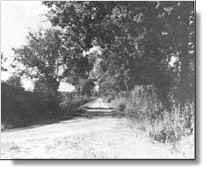
|
| |
|
|
| 1857-1859 |
| Notable New Orleans architect
Henry Howard oversees construction of what
will one day be the National Hansen's Disease (Leprosy) Center
administration building. He also designed Nottoway
Mansion and other historic plantation manor houses
on Louisiana's famous Great River Road. |
| |
|
|
| 1860-1874 |
| Robert C. Camp, now a general
in the Confederate Army, commissions the construction
of the plantation manor house and brings
his troops up from New Orleans for rest and relaxation.
|
| |
|
|
| 1894
-1894 |
| Louisiana meets
the challenge of providing care for leprosy patients
and establishes the Louisiana Leper Home
on the site in what is now known as Carville, Louisiana. Five
men and two women with Hansen's disease, then called
leprosy, were brought by barge to the now-abandoned
sugar plantation on a bend of the Mississippi River
between Baton Rouge and New Orleans. The Louisiana
State Legislature, with Dr. Isadore Dyer, a dermatologist
and leprologist from Tulane University medical school,
establishes the Control Board for the Louisiana
Leper Home, "a place of refuge, not reproach;
a place of treatment and research, not detention."
|
|

|
| |
|
|
| 1896 |
| Dr. Dyer and
Mother Mariana contract an agreement for,
"the nursing of the patients and the household
management," of the Louisiana Home. Four
Catholic Daughters of Charity of St. Vincent de
Paul, from Emmitsburg, Maryland, arrive to provide
care for the patients under the leadership and charge
of Sister Beatrice Hart. |
|
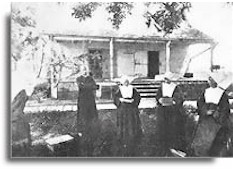 |
| |
|
|
| 1905-1916 |
| State of Louisiana
purchases the property and its contents
in December of 1905. The State provides custodial
care for the patients and funds the first "home"
in the U.S. for patients with leprosy. Many
building improvements are made and the first covered
walkways are constructed. |
|
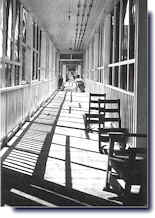 |
| |
|
|
| 1916
|
| Patient John Early testifies
before Congress about the need for a U.S. Hospital
for Leprosy. He believes that a hospital
and research facility can offer the patients hope,
instead of just custodial care in a remote place
away from society. |
| |
|
|
| 1917 |
| An Act to establish a National
Leprosarium in Carville, Louisiana is passed by
the U.S. Senate on February 3. Senate Bill
number 4086 was introduced by William M. Danner,
from the American Leprosy Missions, Rupert Blue,
MD, Surgeon General of the United States Public
Health Service, and Senator Joseph E. Ransdell,
Chairman of the Senate Committee on Health and National
Quarantine. |
| |
|
|
| 1920 |
| The "Home" is sold
by the State of Louisiana to the Federal Government
for $35,000. |
| |
|
|
| 1921
|
| The U.S. Public
Health Service takes operational control and
the "Home" becomes U.S. Marine Hospital
Number 66 ... the National Leprosarium of the United
States. |
|
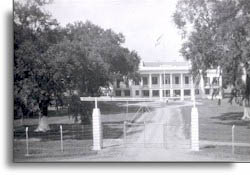 |
| |
|
|
| 1931
|
| Patient Stanley
Stein, aka Carville's Crusader, prints the first
issue of the Sixty-Six Star, a
2-page, in-house patient two-page news sheet. It
later becomes The Star, a world renowned,
international publication. He also writes a book
about his fight for human rights for each of his
fellow patients called Alone No Longer.
|
|
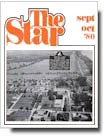  |
| |
|
|
| 1933
|
| A Federal Building
Project enlarges and enhances the safety and well
being of the patients and staff with a
quadrangle of two-story concrete permanent buildings
connected by two miles of enclosed walkways. |
|
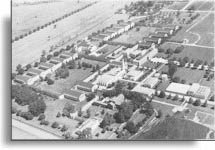 |
| |
|
|
| 1933-1960 |
| Sister Hilary Ross, Daughters
of Charity, and Dr. George Fite, U.S. Public Health
Service officer, start a laboratory for drug testing.
Sister Hilary Ross was a missionary, scientist,
pharmacist, photographer, writer, research biochemist,
international orator and educator in the field of
Hansen's disease. She received some of the
highest awards given by the Federal Government and
supportive organizations for her work and writings
in leprosy. |
|
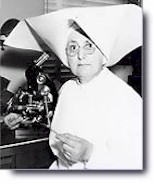 |
| |
|
|
| 1940-1947 |
| Guy Henry Faget,
MD, director, National Leprosarium, U.S. Marine
Hospital 66, pioneers sulfone drug therapy.
Dr. Faget and his staff demonstrate the efficacy
of sulfone drugs, including Promin, Diasone, and
Promizole in the treatment of Hansen's disease,
which gives new hope to people with the disease.
At the end of one year, 15 of 22 patients had improved.
Today, these sulfone drugs are part of the multi-drug
therapy recommended today by the World Health Organization
as effective treatment for Hansen's disease (leprosy). |
|
 |
| |
|
|
| 1946 |
| Patients given the right to
vote. |
|
|
| |
|
|
| 1950 |
| Patient Betty
Martin's autobiography, Miracle at
Carville, hits the New York Times best-sellers
list. |
|
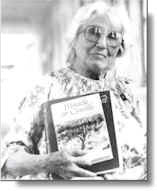 |
| |
|
|
| 1950's |
| The "age of enlightenment"
begins. Rehabilitation, training, education
and patient's rights become a new focus. |
| |
|
|
| 1960's
|
| Dr.
Paul W. Brand begins the first rehabilitation research
program for Hansen's disease patients.
Studies begin in the biomechanics of deformity of
hands and feet. The development of amputation
prevention footcare techniques begin and today also
help people with diabetes and other diseases.
Dr. Brand's methodology of measuring, healing and
prevention techniques and reconstructive surgery
of hands and feet live on today in the National
Hansen's Disease (Leprosy) Program Rehabilitation Research
Laboratory. |
|
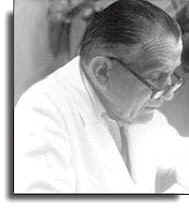 |
| 1970's |
| Captain Robert
C. Hastings, MD, Ph.D., USPHS, defines the
role of thalidomide in leprosy and becomes
the editor of the International Journal of Leprosy.
Thalidomide is supplied by the U.S. Public Health
Service-Carville for Hansen's disease (leprosy) patients in
the United States and Canada only. Because of these
early studies, millions of future patients may be
spared crippling deformity and intense suffering.
|
|
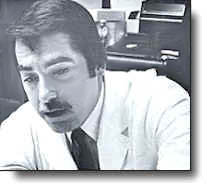 |
| |
|
|
| 1971 |
| Captain
Robert R. Jacobson, MD, Ph.D., USPHS, pioneers drug
resistance and its prevention and Rifampin is introduced
as part of the multi-drug therapy for Hansen's
disease (leprosy) in the U.S. Capt. Jacobson's extensive work
with the World Health Organization helps eliminate
Hansen's disease (leprosy) as a worldwide public health problem.
Dr. Jacobson becomes director of the National Hansen's
Disease Programs in 1992 and serves in that capacity
until his retirement in July 2000. |
|
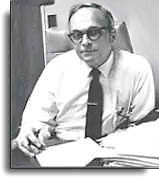 |
| |
|
|
| 1971 |
| Dr. W.F. Kirchheimer,
research scientist, develops the armadillo model
as a tool for the development of systemic disease
similar to human Hansen's disease (leprosy). M. leprae
has not been cultivated on artificial laboratory
media to date. Today Hansen's disease (leprosy) bacilli
are provided for researchers worldwide. |
|
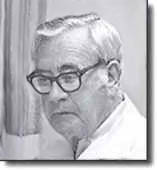 |
| |
|
|
| 1981 |
| Regional Hansen’s disease
clinics are established to provide outpatient care
for Hansen’s disease (leprosy) patients.
Eleven community health programs are begun: Boston,
Chicago, Los Angeles, Miami, New York, Puerto Rico,
San Diego, San Francisco, Seattle, Texas and Hawaii.
Services provided include: diagnosis, treatment,
follow-up, contact monitoring, disability prevention,
education (professional, patient, public), maintenance
of referral system for Hansen's disease health care
services and maintenance of Hansen's disease registry
and database. |
|
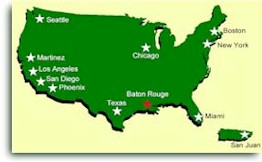 |
| |
|
|
| 1982
|
| The newly-established Health
Resources and Services Administration, U.S. Department
of Health and Human Services, assumes responsibility
for the management and operation of the Hansen's disease (leprosy) facility
at Carville. |
| |
|
|
| 1986 |
| The
facility becomes the Gillis W. Long Hansen’s
Disease (Leprosy) Center, named after the distinguished
United States Congressman, close friend and associate
of the people working and living with Hansen's disease (leprosy).
|
|
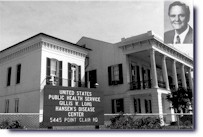 |
| |
|
|
| 1992
|
| Carville Historic
District placed on the National Register of Historic
Places by the National Park Service. |
| |
|
|
| 1992 |
| The Hansen's Disease
(Leprosy) Center Laboratory Research Branch moves to the Louisiana
State University School of Veterinary Medicine
in Baton Rouge. |
| |
|
|
| 1993 |
| The Joint Commission on Accreditation
of Healthcare Organizations (JCAHO) awards
the Gillis W. Long Hansen’s Disease (Leprosy) Center
facility its highest level of accreditation,
a three year accreditation with commendation. |
| |
|
|
| 1994 |
The Hansen's Disease
Center holds its centennial celebration
(1894-1994) |
|
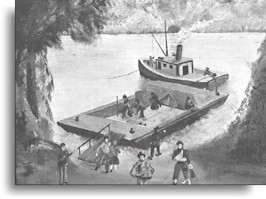 |
| |
|
|
| 1995
|
| The Hansen's Disease Center
is awarded a $3.5 million grant to test drugs that
fight tuberculosis. The grant is headed
by Dr. James Krahenbuhl, director of the laboratory
research branch. |
| |
|
|
| 1996 |
| Centennial celebration
of the Daughters of Charity of St. Vincent de Paul’s
arrival in 1896 to care and manage the
facility for patients with Hansen's disease (leprosy). |
|
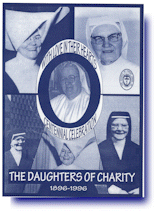 |
| |
|
|
| 1996 |
| The National Hansen’s
Disease (Leprosy) Museum is founded. The museum
becomes a reality as a result of exhibit items collected
for the 1994 Carville Centennial and the 1996 100-year
anniversary of the arrival of the Daughters of Charity
of St. Vincent de Paul at Carville. |
| |
|
|
| 1998 |
| The U.S. Congress passes
a bill to relocate the Gillis W. Long Hansen’s
Disease (Leprosy) Center to Baton Rouge, Louisiana. The
bill is authored by Congressman Richard Baker (R-LA).
|
| |
|
|
| 1999
|
| The U.S. Government returns
title to Indian Camp Plantation to the State of
Louisiana, which locates a new program for at-risk
youths, supervised by the Louisiana National Guard.
|
|
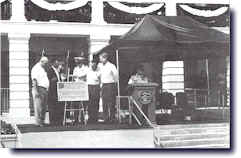 |